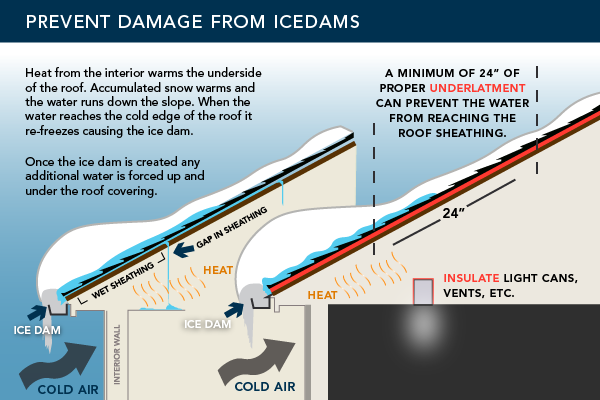Ways to help avoid damage from ice dams
Avoid the costly collision of hot and cold and reduce the risk that ice dams will form and create a soggy mess. When heat from the interior of a building with a sloped roof escapes into the attic space, it warms the underside of the roof. Meanwhile, the roof eave outside the heated space remains at a colder temperature.
As snow accumulates on the rooftop, it melts over the warmer portion of the attic and runs down the roof. When it encounters the cold edge of the roof it refreezes. The refrozen water along the roof edge creates an “ice damming” condition, and consequently, the melted snow running down the roof begins to back up underneath the roof covering.
This water will soak the roof sheathing and leak into the attic unless there is a barrier above the sheathing. An appropriately installed secondary moisture barrier will help prevent the water from entering your property and damaging your structure and its contents.
Reducing damage from ice dams
Ventilating and insulating your attic can help prevent ice dams. If you are faced with an ice dam, however, there are ways to mitigate the damage from it.
Steps you can take to reduce the damage from an ice dam:
- Remove ice and snow from the roof to allow proper drainage.
- Be careful when performing this task as you can fall, be struck by falling objects or contact electrical lines.
- Use a snow rake to remove the snow from the ground, if possible.
- Make a path to relieve water buildup.
- If there is an existing ice dam, melt a channel through the ice to the roof surface to create a drain path to relieve water buildup.
- An easy way to do this is to fill the leg of pantyhose with calcium chloride ice melter and place that on the roof. The long tube can melt a patch through the ice to allow drainage. You can refill or replace the ice melter to keep the channels open. Make sure the channel extends to the roof edge or gutter.
- Engage the services of your roofing contractor to remove ice buildup.
- If you observe water damage, hire a restoration service to dry out the walls, ceiling and structure. Not addressing minor damage can cause rot, decay and more extensive problems.
- To prevent future issues, contact your roofer and an insulation company to correct the ventilation and heat transfer issues in your attic.
- Add ice and water shield (for roof replacements).
- When replacing a roof, add an ice and water shield membrane at the edge of the roof and extend it at least five feet up the roof to protect this area against water intrusion.
This material is provided for informational purposes only and does not provide any coverage or guarantee loss prevention. The examples in this material are provided as hypothetical and for illustration purposes only. The Hanover Insurance Company and its affiliates and subsidiaries (“The Hanover”) specifically disclaim any warranty or representation that acceptance of any recommendations contained herein will make any premises, or operation safe or in compliance with any law or regulation. By providing this information to you, The Hanover does not assume (and specifically disclaims) any duty, undertaking or responsibility to you. The decision to accept or implement any recommendation(s) or advice contained in this material must be made by you.
171-0791 (9/20) LC11-61



